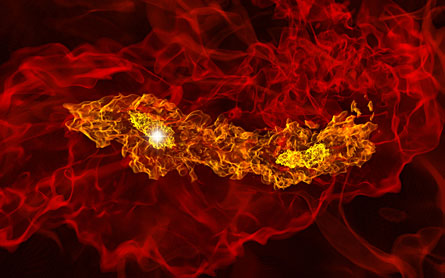It’s usually nice to have a companion. And in the lonely, dark expanse of the early universe, even some of the first stars had soul mates, new simulations reveal.

Previous studies had indicated that the first stars were extraordinarily massive — at least 100 times as heavy as the sun — but were also loners (SN: 6/8/2002, p. 362). Now, more detailed modeling, including a careful consideration of how atomic and molecular hydrogen interact at low densities, reveals that at least 5 percent and perhaps as many as half of these heavyweights were gravitationally bound to similar-mass companions, says Tom Abel of Stanford University He and his colleagues, Matthew Turk of Stanford and Brian O’Shea of Michigan State University in East Lansing, report their findings online July 9 in Science.
Pairs of massive stars are intriguing, notes Abel, because each star will probably collapse into a black hole. The coalescence of the two black holes would be a key source of gravitational waves, ripples in space-time predicted by Einstein’s theory of general relativity but never directly detected.
A second star’s presence could also enhance the production of distant gamma-ray bursts, flashes of high-energy light that have long-lasting afterglows and provide a window on the early universe. Gamma-ray bursts are produced when a single, massive star that crunches down into a black hole generates powerful jets of particles. A companion star can spin up its partner, and such rapid rotation may help generate the energetic jets, Abel says.
Star formation in the early universe is relatively easy to model because the infant cosmos contained only a few elements — mainly hydrogen and helium gas — which cooled and collapsed to produce stars. But even the simple interactions between atomic and molecular hydrogen hadn‘t been previously studied at low-enough densities, Abel says. He and his colleagues followed the star-forming process about 200 million years after the Big Bang, as gravity condensed gas clouds, to much higher densities than his team could in past simulations, Abel adds.
Only one in five of the team’s simulations produced stellar pairs, and for now the researchers can only provide a rough estimate of the percentage of first stars that would have had partners. He expects that within a year, larger, more comprehensive simulations will pin down the number.
The first generation of stars is not visible with today’s telescopes, but the proposed successor to Hubble, the infrared James Webb Space Telescope, scheduled for launch in 2014, has a good chance of recording large groupings of these earliest of glimmers.
“The simulations make good sense,” says theorist Volker Bromm of the University of Texas at Austin. Bromm says that his own team’s simulations track the evolution of pairs or groups of embryonic stars for an additional 100,000 years beyond that of Turk’s group — a necessity, he says, to determine if the baby stars merge into one big star or remain separate. His team indeed finds that the fledgling stars remain close partners. Bromm says his team plans to post a paper online describing the results later this month.







